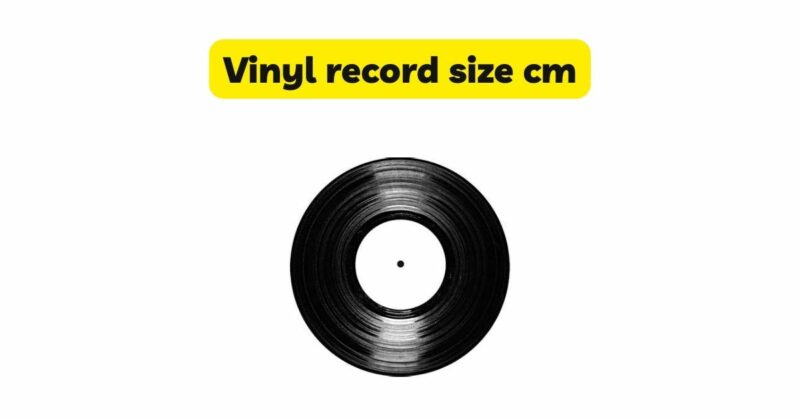Vinyl records have witnessed a remarkable resurgence in recent years, offering a unique listening experience cherished by music enthusiasts worldwide. Understanding the size of vinyl records in centimeters (cm) is essential for storage, playback compatibility, and overall appreciation. In this article, we will delve into the dimensions of vinyl records, exploring their measurements in centimeters and discussing their significance in the world of vinyl.
- The Significance of Vinyl Record Size in Centimeters: The size of a vinyl record in centimeters plays a crucial role in various aspects of the vinyl experience, including storage, compatibility with playback equipment, and handling. Understanding these dimensions ensures accurate measurement, assessment, and appropriate usage of vinyl records, contributing to their preservation and overall enjoyment.
- Standard Vinyl Record Sizes: Vinyl records come in several standard sizes, each with its own set of characteristics and purposes. The most common formats include 12-inch, 10-inch, and 7-inch records. Let’s explore their size measurements in centimeters:
a) 12-Inch Vinyl Records: The standard size for a 12-inch vinyl record is approximately 30 cm in diameter. These larger records are commonly used for full-length albums, offering extended playing times per side, wider grooves, and improved sound quality. The 30 cm measurement ensures compatibility with turntables and playback equipment designed for 12-inch records.
b) 10-Inch Vinyl Records: The standard size for a 10-inch vinyl record is approximately 25 cm in diameter. 10-inch records provide a shorter playing time per side compared to 12-inch records and are often used for EPs (Extended Plays) and smaller releases. The 25 cm measurement aids in selecting appropriate turntables and tonearms designed for 10-inch records.
c) 7-Inch Vinyl Records: The standard size for a 7-inch vinyl record is approximately 17 cm in diameter. These smaller records, commonly known as singles, have a shorter playing time and are frequently collected for their historical and cultural significance. The 17 cm measurement ensures accurate identification and compatibility with turntables and playback equipment designed for 7-inch records.
- Groove Dimensions and Audio Fidelity: In addition to the diameter, the dimensions of the grooves on a vinyl record significantly impact audio fidelity and overall sound quality. The width and depth of the grooves directly affect how the stylus tracks the record, capturing the audio information. While groove dimensions are not typically measured in centimeters, they contribute significantly to the playback performance and sonic experience.
- Handling and Storage Considerations: Understanding the size of vinyl records in centimeters is crucial for proper handling and storage. Vinyl records should be handled by their edges to avoid fingerprints and potential damage to the playing surface. When storing vinyl records, selecting appropriately sized sleeves, jackets, or record boxes ensures a secure fit and protects them from dust, scratches, and warping. Knowledge of the size measurements enables vinyl enthusiasts to choose the correct storage solutions.
- Compatibility with Playback Equipment: The size of a vinyl record in centimeters is instrumental in ensuring compatibility with turntables, tonearms, and other playback equipment. Turntables and tonearms are designed to accommodate specific record sizes, ensuring proper tracking, stability, and playback performance. By understanding the size measurements, enthusiasts can select the appropriate playback equipment for their vinyl record collection.
- Custom and Non-Standard Sizes: While standard sizes are prevalent, it is worth noting that custom and non-standard sizes of vinyl records exist. Some niche genres, limited editions, or special releases may feature unique sizes or shapes, providing collectors with a distinct visual and auditory experience. These non-standard sizes may deviate from the standard measurements, adding diversity to vinyl record collections.
- Display and Aesthetic Appreciation: The size of vinyl records in centimeters also contributes to their display and aesthetic appreciation. Larger records can be prominently displayed on shelves or mounted on walls, showcasing the album artwork and adding visual appeal to a music collection. Smaller records can be creatively arranged or presented in specialized frames, emphasizing their unique dimensions.
Conclusion: Understanding the size of vinyl records in centimeters, whether they are 12-inch, 10-inch, or 7-inch formats, is crucial for proper storage, compatibility with playback equipment, and overall appreciation. These measurements ensure accurate selection of storage solutions, appropriate playback equipment, and proper handling techniques. As vinyl records continue to captivate music enthusiasts, the size measurements in centimeters remain fundamental in the enduring appeal and enjoyment of these cherished musical formats.

